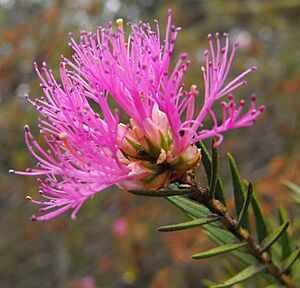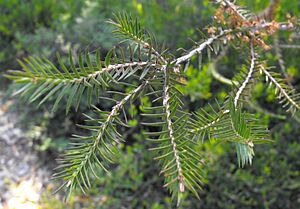Wilson's honey-myrtle facts for kids
Quick facts for kids Wilson's honey-myrtle |
|
|---|---|
 |
|
| M. wilsonii (cultivated) in Maranoa Gardens, Victoria | |
| Scientific classification | |
| Genus: |
Melaleuca
|
| Species: |
wilsonii
|
The Melaleuca wilsonii, also known as Wilson's honey-myrtle or violet honey-myrtle, is a special plant from the myrtle family. You can find it growing naturally in parts of South Australia and Victoria. This plant is a type of shrub with thin, pointed leaves. It has beautiful purplish-pink flowers that grow in clusters along its branches. It's a tough plant that can grow in many different kinds of soil and can handle cold weather. Because of this, people often grow it in gardens.
Contents
What Does Wilson's Honey-Myrtle Look Like?
Wilson's honey-myrtle is a thick shrub that can grow up to 2 m (7 ft) tall. It often spreads out to be 3 m (10 ft) wide. Its bark is rough and can be flaky or corky.
Leaves
The leaves of this plant are arranged in a special way. They grow in pairs, with each pair at a right angle to the pair below it. This pattern is called decussate. The leaves are usually 8–15 mm (0.3–0.6 in) long and 1–2 mm (0.04–0.08 in) wide. They get narrower towards the end, forming a point.
Flowers
The flowers of Wilson's honey-myrtle grow on the older parts of the branches. They form clusters that can be up to 10 cm (4 in) long and 25 mm (1 in) across. The flowers can be light pink, dark pink, or a pretty lilac color. Each flower has bundles of stamens, which are the parts that produce pollen. There are five bundles around each flower, with 6 to 15 stamens in each bundle. The petals are brown and fall off easily.
When It Blooms and Fruits
Wilson's honey-myrtle usually blooms from October to December. The busiest time for flowering is in the first few weeks of November. After the flowers, the plant produces woody fruits called capsules. These capsules are 2.5–3.5 mm (0.098–0.14 in) long and have a scaly look. The green leaf-like parts of the flower, called sepals, stay on the fruit as small teeth.
How It Got Its Name
The scientific name for this plant, Melaleuca wilsonii, was first officially written down in 1861. This was done by Ferdinand von Mueller, who was a botanist for the state of Victoria. He described the plant from samples collected by Reverend Julian Tenison-Woods and John Dallachy.
Meaning of the Name
The second part of the name, wilsonii, is a tribute to a person named Charles Wilson. He was a friend of Mueller's and helped bring this plant to the botanist's attention. This plant is part of a very large group of plants called Melaleuca. This group includes many different types, from tall trees to small shrubs.

Where Wilson's Honey-Myrtle Grows
This type of melaleuca grows in the southeastern part of South Australia. It also grows across western and central Victoria. You can find it in areas where the soil often gets flooded or doesn't drain well. It grows in open scrubland, in forests with eucalypt trees, and in a type of shrubland called mallee heath.
Uses of Wilson's Honey-Myrtle
Growing It in Gardens
Wilson's honey-myrtle is a popular plant for gardens. It grows well in many types of soil, from light to heavy. It prefers a sunny spot where the water drains away easily. This plant is also very good at handling both frost and dry weather. If you live in a very humid place, it might not flower as much, and the flowers might wilt quickly. It was first grown in gardens in England in 1874. It's not as common in the United States. The flowers are great for attracting birds and insects to your garden. Many people think it's a wonderful plant to grow. You can grow new plants from its seeds or by taking cuttings from an existing plant.


